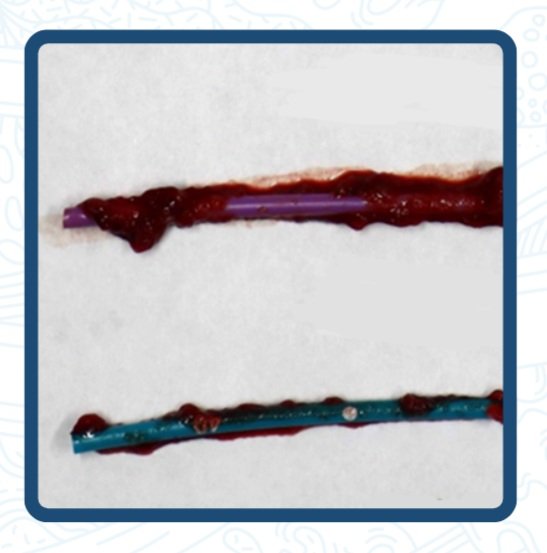Foreign Body Response to Intravenous Catheter Materials
Nancy Moureau, PhD, RN, CRNI, CPUI, VA-BC
Our body's normal reaction to foreign objects inserted into the bloodstream involves proteins sticking to them and the activation of immune cells as a protective process engulfing the object. Understanding how the body and devices, such as intravenous catheters, interact with the cells within the bloodstream is crucial to avoiding problems and device failures. After the insertion, proteins from blood and tissue stick to the surface of the device, setting off a response influenced by factors like the type of material the device is made of and how long it's inside the bloodstream. This response to foreign materials usually goes through two phases: an initial buildup of fluid and proteins followed by the arrival of inflammatory cells and changes in tissue. Eventually, the body forms a fibrous capsule around the catheter, isolating it from surrounding tissue.
Central venous catheters (CVCs) are essential for patient care and the delivery of life-saving treatments, but they can lead to serious issues like central line-associated bloodstream infections (CLABSIs) and catheter-related thrombosis or clots. These complications develop as a byproduct of the foreign body response and catheter surface changes caused by plasma protein adsorption. These various proteins continue to impact the body, stimulating inflammation and blood clots. This cellular inflammatory response starts with the catheter and can spread throughout the body, causing venous thrombosis and systemic inflammation that may lead to bloodstream infection.
Ensuring that biomaterials interact well with our bodies is a major concern in research. We need materials that don't cause trouble locally or throughout our system and can do their job without complications, toxicity, or cancer risks. Researchers are exploring ways to improve catheter biocompatibility and minimize the body’s natural immune response. Recent advancements have focused on developing better materials, including hydrophilic composites, to reduce the body's response to catheters. These advances aim to make catheters more compatible with our bodies, which could cut down on blood clots, catheter failure, and infections. This ongoing research in biomaterials is key for improving patient outcomes and making medical devices safer.
Hydrophilic intravenous catheter materials have gained attention for their potential to reduce the body’s natural response so that the blood proteins are less likely to stick to the catheter material and trigger clot formation. These hydrophilic hydrogel materials attract and hold onto moisture. The water-loving characteristics of these composite catheters play a significant role in reducing the ability of blood proteins to adhere to the catheter's surface, which is a key trigger for the body's immune response and subsequent inflammation.
On top of that, the smooth and moist surface provided by hydrophilic materials can prevent rough spots where blood cells and proteins might stick and start clotting. By keeping a smoother and more even surface, hydrophilic catheter materials may help stop or prevent the early stages of clot formation.
In addition, because hydrophilic materials don't allow blood proteins to stick to surfaces readily, there's less chance of CLABSIs. Bacteria often cling to blood proteins and form biofilms on the catheter's surface, leading to microorganism growth, aided by biofilm formation. By minimizing the amount of protein that sticks to the catheter’s surface, hydrophilic materials create a less hospitable environment for bacterial colonization which, in turn, reduces biofilm formation and lowers the risk of CLABSIs.
All in all, hydrophilic intravenous catheter materials show real promise in reducing the body's natural reaction to foreign bodies. By minimizing inflammation and clotting, these novel materials could make intravenous catheter procedures and catheter usage safer and more effective. This progress with catheter materials underscores the importance of ongoing research in biomaterials science to improve patient outcomes and reduce the risk of device-related complications.
Bibliography
Aslam S. Effect of antibacterials on biofilms. American journal of infection control. 2008 Dec 1;36(10):S175-e9.
Aswathy SH, Narendrakumar U, Manjubala I. Commercial hydrogels for biomedical applications. Heliyon. 2020 Apr 1;6(4):e03719.
Cangui-Panchi SP, Ñacato-Toapanta AL, Enríquez-Martínez LJ, Reyes J, Garzon-Chavez D, Machado A. Biofilm-forming microorganisms causing hospital-acquired infections from intravenous catheter: A systematic review. Current Research in Microbial Sciences. 2022 Nov 17:100175.
Correa S, Grosskopf AK, Lopez Hernandez H, Chan D, Yu AC, Stapleton LM, Appel EA. Translational applications of hydrogels. Chemical Reviews. 2021 May 3;121(18):11385-457.
Donlan RM. Biofilm elimination on intravascular catheters: important considerations for the infectious disease practitioner. Clinical infectious diseases. 2011 Apr 15;52(8):1038-45.
Gominet M, Compain F, Beloin C, Lebeaux D. Central venous catheters and biofilms: where do we stand in 2017? Apmis. 2017 Apr;125(4):365-75.
LeRoy KJ, Donahue DT. Trackability of a high-strength thromboresistant hydrogel catheter: An In vitro analysis comparing venous catheter forces in a simulated use pathway. Journal of the Mechanical Behavior of Biomedical Materials. 2023 Mar 1;139:105670.
Mannarino MM, Bassett M, Donahue DT, Biggins JF. Novel high-strength thromboresistant poly (vinyl alcohol)-based hydrogel for vascular access applications. Journal of Biomaterials Science, Polymer Edition. 2020 Mar 23;31(5):601-21.
Morais JM, Papadimitrakopoulos F, Burgess DJ. Biomaterials/tissue interactions: possible solutions to overcome foreign body response. The AAPS journal. 2010 Jun;12:188-96.
Moureau NL, McKneally E, Hofbeck D, Sharp J, Hanley B., Williams V. Integrative Review: Complications of Peripherally Inserted Central Catheters (PICC) and Midline Catheters with Economic Analysis of Potential Impact of Hydrophilic Catheter Material. Int J Nurs Health Care 2022;5:1347. DOI: https://doi.org/10.29011/2688-9501.101347
Pathak R, Bierman SF, d’Arnaud P. Inhibition of bacterial attachment and biofilm formation by a novel intravenous catheter material using an in vitro percutaneous catheter insertion model. Medical Devices: Evidence and Research. 2018 Dec 19:427-32.
Ryder MA. Catheter-related infections: it’s all about biofilm. Topics in Advanced Practice Nursing eJournal. 2005 Aug;5(3):1-6.
Treter J, Macedo AJ. Catheters: a suitable surface for biofilm formation. Science against microbial pathogens: communicating current research and technological advances. 2011;2(3):835-42.


